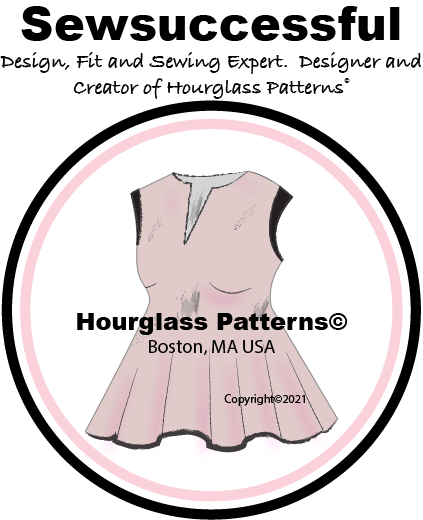Basics about Ease:
New Worksheet on ETSY: Ease Worksheet on ETSY. Hourglass Patterns Calculation Worksheet for Fit and Ease. Handy one page PDF worksheet used to adjust any sewing pattern by any designer.
Ease is the difference in size between the body and the garment. Ease is necessary for any garment's comfort. You have 3 types of Ease:
-Fitting Ease: Minimal ease that would only act as a shell on the body....think slopers or muslins.
-Basic Wearing Ease: The necessary easy needed to move comfortably in a garment. Generally this would be as follows: Bust and hips: 2", Waist: 1/2-1", Arm biceps: 1 1/2-2", Elbow: 1 1/2-2", Wrist: 1"
-Style Ease: This is the ease the designer adds to create a specific style. Think of a big boxy sweater. This would have alot of style ease in the waist and hips and probably alot of ease in the shoulders.
The Number 1 question I'm asked on my ETSY store platform is: "Will this pattern fit me?". My newer patterns have a detailed description about ease. I state how much ease you can expect from the garment at the bust, waist and hips. However, you may come across an older pattern that does not have this description....so what do you do? I always recommend with any pattern that you assemble the pattern per the instructions, and before you cut a size, plot your body measurements on the pattern so you can see how your measurements compare to the pattern. This will allow you to not only see how much ease is built into the pattern, but will allow you to grade between sizes.
Here's an Example using my Mock Neck Long Sleeve Top. For sake of demonstration, I'm using only the Front Bodice Piece. The Back Bodice Piece is the exact same size, so whatever I plot is my measurements divided by 4, plus the 5/8" seam allowance.
The Pink Line represents my body measurements (Bust, Waist, Hip) plotted. The Blue Line represents the pattern sizing. I always select my pattern based on bust size. So I selected the Size 10. You can see from the image below, that if I make the size 10 without any grading, I will have a very close fitting garment with only about 1" of ease in the waist. This is great since I know this pattern is designed for knits and I'm looking for something with fitting ease and possibly negative ease because I'm using a stretchy double brushed poly. I would probably keep the ease amount as designed in the waist and only alter it as needed in the pin fitting process (I always baste my patterns before sewing this way I get the perfect custom fit). However, what if I'm working with a more stable knit like a light weight fleece? Well, I know the pattern was designed for knits, but the stated knits it was designed for does not include fleece. In this case I would determine how much ease I want to add in order to adopt the pattern to fleece. I like to play it safe....here's what I would add:
Bust and hips: 2"
Waist: 1"
Arm biceps: 1 1/2-2"
Elbow: 1 1/2-2"
Wrist: 1"
Length
Bodice: 1-1 1/2"
Arm: 1-1 1/2"
Arm: 1/2-3/4" in Sleeve Cap
You could also cut 1-2 sizes larger and baste the entire garment before sewing.
When you buy a pattern, you're buying the design. You want to keep the integrity of that design whilst getting the best fit.
Here's a link to my fit and ease worksheet for purchase on ETSY: Hourglass Patterns Fit and Ease Calculation Worksheet
This also brings up another topic: Seamline Placement. Seamlines divide the body. You can't have a good fitting garment if the seamliness are not hanging perpendicular to the floor. They need to divide the body proportionally in a pleasing manner. Sometimes this means you need to shift those seamlines in order to achieve that optimal proportion. For-instance a prominant abdomen or large buttocks means you need to shift the side seam slightly forward or backward to achieve better visual balance by dividing the body into two equal parts.
To sum this up you need to work on 2 critical divisions: The Shoulder's seamlines and the side seamlines. I will cover this in a separate post since I'll need to add some visuals and it's a rather important topic that warrants greater attention.


